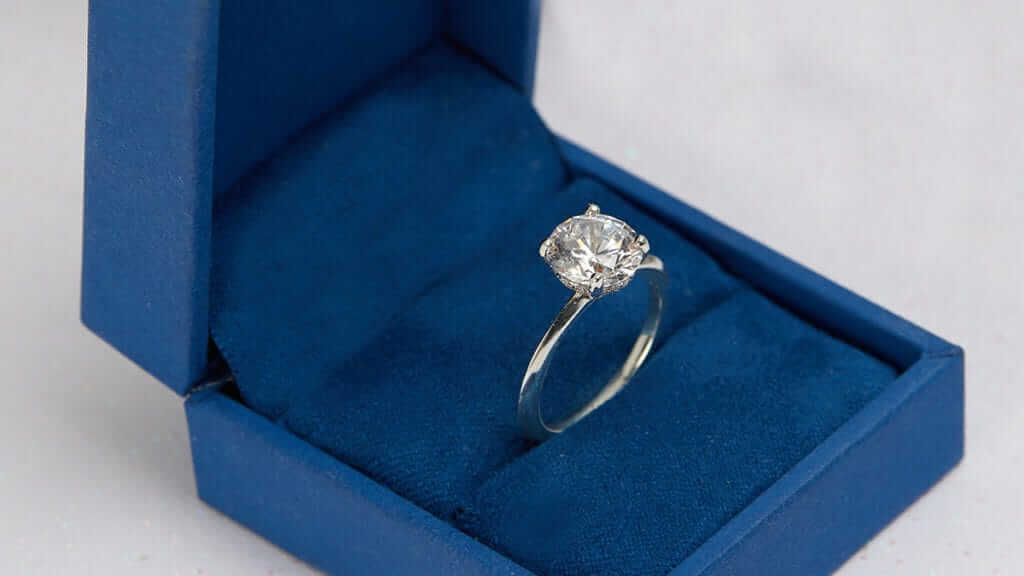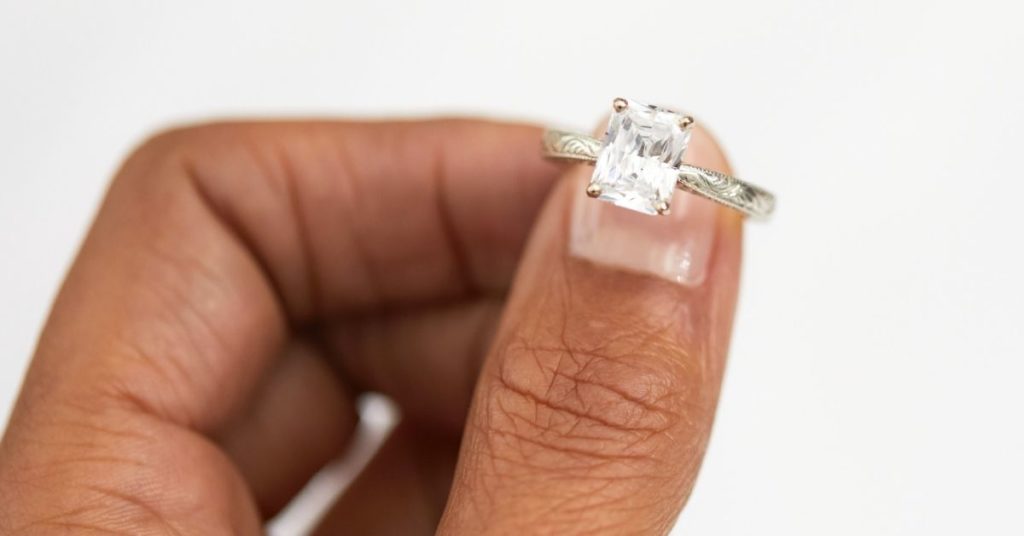Although rhodium isn’t a well-known jewelry term, it plays a crucial function in the polish and longevity of your solid pieces. Rhodium plating, for example, improves the shine of common solid pieces like silver and white gold. It also gives ring materials a lustrous sheen and a smoothness.
While rhodium plating is advantageous for jewelry applications, it does require reasonable care and re-plating with time. First and foremost, we need to understand what rhodium is.
What is a Rhodium?
Rhodium is a white metal that jewelers use for finger rings, necklaces, earrings, etc. It is whiter than silver and rarer than gold or platinum. Since the metal is so rare, the easiest way to collect it is as a byproduct from platinum mines. Platinum, rhodium, iridium, ruthenium, osmium, and palladium are all platinum group members, including platinum, rhodium, iridium, ruthenium, osmium, and palladium. The excellent luster, reflectivity, and strength of rhodium make it desirable in vehicles, lights, mirrors, and jewelry.
The Comparison Between Rhodium and Platinum

Rhodium and platinum are silvery precious metals belonging to the same metal family. Platinum is useful for extracting rhodium, and the two metals are both scarce and valuable. Rhodium is even more valuable than platinum due to its scarcity. However, because rhodium becomes brittle when the thickness exceeds 1.0 microns, a jeweler cannot make items entirely out of rhodium. Platinum is more pliable than gold, copper, or diamonds and does not crack. It’s a material that makes jewelry easy to care for and long-lasting.
On the other hand, Platinum jewelry is more expensive than rhodium plated jewelry, even though platinum is a less valued metal. Rhodium jewelry has only a thin layer of fine metal on it. Thus fine jewelry pieces are costing more while still being stunning.
What is Rhodium Plating?

The element rhodium is a member of the platinum family. It plates other ring metals and offers a layer of protection to jewelry. Rhodium is significantly harder than gold, making it a long-lasting protective coating for metals. Rhodium is likewise extremely uncommon, making it around 10 to 25 times more expensive than gold. It can, however, protect your valuable jewels, precious metals, and gemstones. Rhodium is, in a nutshell, an investment in the protection of your treasures.
Rhodium has a platinum-like silver color and is corrosion and tarnishing resistant. On the other hand, Pure rhodium is not a typical metal in jewelry. In truth, rhodium is a delicate metal that readily breaks. When rhodium forms a protective plate for other jewelry parts, the piece becomes stronger and more durable. Rhodium plating is also known as “rhodium flashing” or “rhodium dip.”
In essence, rhodium plating extends the life of your jewelry. Should you have your jewelry rhodium plated in light of this?
What Are the Benefits of Rhodium Plating?

Generally, rhodium plating gives jewelry a lustrous gloss and a delicate glow of light reflection. It also increases the jewelry’s longevity and makes it more resilient to scratching and corrosion.
While rhodium is too costly and delicate for jewelry, it is an excellent plating material. It can mask or hide imperfections and give silver or white gold jewelry a better gloss. Because it is harder than both silver and gold, it is an excellent finished product and protective covering for jewelry that protects it from scratches. One of its most appealing features is that it does not tarnish and does not need any special cleaning techniques. Customers who experience nickel allergies should consider rhodium-plated jewelry because it protects them from direct contact.
Hypoallergenic
One of the most common concerns with any jewelry item is whether it may cause skin irritation. Rhodium-plated jewelry is hypoallergenic, which is a huge plus. This means you won’t have to worry about rhodium jewelry causing an allergic reaction.
Nickel is the most common cause of skin reactions. Having your nickel jewelry, or any jewelry produced from an alloy containing nickel, rhodium-plated is a viable solution to this problem.
Is Rhodium Jewelry Safe?

Yes, it is true. Wearing rhodium plated jewelry will not cause skin allergies because rhodium plating is hypoallergenic. This is because rhodium does not include any allergens like nickel. In reality, rhodium plating a piece of jewelry that gives you skin sensitivities may solve the problem.
Nevertheless, while rhodium doesn’t entirely cause rashes on its own, white gold alloys frequently contain nickel. As the rhodium plating wears off, your skin may come into contact with the original metal of the jewelry, exposing you to nickel allergy.
What Type of Jewelry Does Rhodium Plating Work With?

Rhodium plating most commonly coats silver-colored metals. Let’s take a closer look at this.
Sterling Silver
Sterling silver can tarnish over time. Therefore, rhodium-plated silver can help maintain the metal’s shine and preserve it from tarnishing.
Yellow Gold
Rhodium plating is an excellent way to turn yellow gold into white gold. As the plating wears off over time, a yellow tinge may show, signaling that it’s time to get that jewelry re-plated.
Hard Gemstones
Gemstones such as rubies, copper, and sapphires are ideal for rhodium plating. On the other hand, the rhodium plating procedure might harm softer stones like pearls, turquoise, and opal.
Is my existing jewelry coated with rhodium? Because gold’s natural hue is yellow, white gold rings in your jewelry collection are rhodium plated. You can ask a jeweler to examine your jewelry if you’re unsure if it’s rhodium plated.
How Thick Should a Rhodium Plate Be?

The most common rhodium plating thickness is 0.75 to 1.0 microns. This thickness provides ample room for jewelry to be protected from wear and tear. Although it may appear to be a minor detail, rhodium plating cannot be too thick, or it may crack. On the other hand, the jewelry will tarnish if it has a thin layer. The plating thickness is highly dependent on the piece of jewelry being plated. Thus, the reason for consulting a jeweler expert is essential.
How Does Rhodium Plating Work?

Cleaning your jewelry thoroughly is the first step in getting it rhodium plated. Remember, you must remove all dirt and particles before plating, or the plating will not hold. Steam cleaning, electro cleaning, or distilled water are all choices for thoroughly cleaning your jewelry. Rhodium plating is applied after the jewelry has been cleaned. The rhodium solution is dipped into the jewelry piece during the electroplating procedure. With an electrical charge, the rhodium fuses with the base metal.
How Long Does Rhodium Plating Last?
Rhodium plating’s durability is ultimately determined by wear and tear. A rhodium-plated ring, for example, can wear down over time since it is worn daily, just like other metals. It all boils down to everyday wear and the rhodium layer thickness. Certain elements may need to be re-plated every year or so. This is especially true with rings known to be worn every day.
How Can You Make Rhodium Plating Last Longer?

Rhodium plating requires some upkeep to keep the shine bright and the metal beneath safe. Here are some suggestions for extending the life of your rhodium-plated jewelry:
- When you wash your hands, take off your rhodium-plated piece of jewelry since the rubbing can cause the plating to wear off faster.
- Because harsh chemicals and fragrances might cause the rhodium to wear, use unscented soaps and lotions.
- Swimming in a pool with your rhodium earrings and ring might cause the plating to corrode.
How Much Does Rhodium Plating Cost?

The type of jewelry determines the cost of rhodium plating. However, because the substance is a precious metal, the cost of the service may rise. Investing in rhodium plating ensures that your valuable jewelry is protected and lasts a long time.
The cost of rhodium plating isn’t only one-time. You may need to have your jewelry rhodium plated numerous times over time, which can add up to a significant financial price. If rhodium isn’t your thing, look for other metals with a flash of natural brilliance, such as platinum.
The truth is that any high-quality jewelry needs consistent maintenance, polishing, and cleaning. Scratches and tarnishing are unavoidable when we wear our treasured possessions. Finally, rhodium plating adds a layer of brilliance and durability to your jewelry, ensuring that it remains as beautiful as the day you acquired it.



